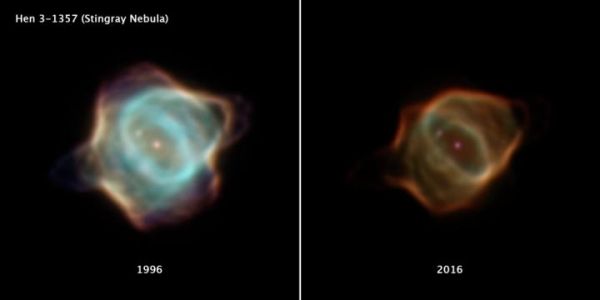Astronomers have caught a rare look at a rapidly fading shroud of gas around an aging star. Archival data from NASA’s Hubble Space Telescope reveal that the nebula Hen 3-1357, nicknamed the Stingray nebula, has faded precipitously over just the past two decades. Witnessing such a swift rate of change in a planetary nebula is exceeding rare, say researchers.
Images captured by Hubble in 2016, when compared to Hubble images taken in 1996, show a nebula that has drastically dimmed in brightness and changed shape. Bright, blue, fluorescent tendrils and filaments of gas toward the center of the nebula have all but disappeared, and the wavy edges that earned this nebula its aquatic-themed name are virtually gone. The young nebula no longer pops against the black velvet background of the vast universe.
“This is very, very dramatic, and very weird,” said team member Martín A. Guerrero of the Instituto de Astrofísica de Andalucía in Granada, Spain. “What we’re witnessing is a nebula’s evolution in real time. In a span of years, we see variations in the nebula. We have not seen that before with the clarity we get with this view.”
Read more at: NASA/Goddard Space Flight Center
This image compares two drastically different portraits of the Stingray nebula captured by NASA's Hubble Space Telescope 20 years apart. The image on the left, taken with the Wide Field and Planetary Camera 2 in March 1996, shows the nebula's central star in the final stages of its life. The gas being puffed off by the dying star is much brighter when compared to the image of the nebula at the right, captured in January 2016 using the Wide Field Camera 3. The Stingray nebula is located in the direction of the southern constellation Ara (the Altar). (Photo Credit: Credits: NASA, ESA, B. Balick (University of Washington), M. Guerrero (Instituto de Astrofísica de Andalucía), and G. Ramos-Larios (Universidad de Guadalajara))


